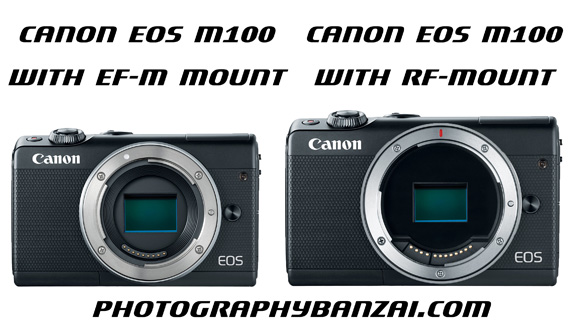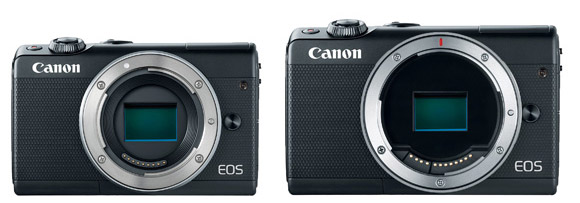I hope there is a future for EF-M, but the announcement of the RF mount system brings that into question. In the photo below I made a mock-up of the M100 if it had the RF mount instead of the EF-M mount. Of course they could make a camera with shorter sides, but this shows the potential size difference if everything besides the mount diameters were the same design. Edit: I decided to go all-in on EF-M gear for now. The added kit will expand capabilities and make it even easier to be mobile.

I guess we shouldn’t be shocked. Canon would not have wanted to put themselves at a disadvantage to Nikon in the mount diameter department with their mirrorless full-frame camera. These two companies are almost always in lockstep, so much so that they disregard other offerings in the market (*cough* Sony…). That said, will Canon drop EF-M like Nikon dropped their “Nikon 1” system? Plus, having the RF mount the same diameter as the EF mount makes a lot of sense… Why didn’t the original EOS M start this way? We can only speculate.
Keep in mind that a discontinued mount doesn’t means it’s no longer a viable tool under most circumstances. What it does mean is that you will no longer have new camera bodies with current features. You no longer have the potential of buying new replacements if your camera(s) break in some way. It means that you no longer can buy new lenses for the system and you are limited to what was released when the mount was active. Short flange mirrorless has the benefit of lens adaptation which negates some of this.
Of course, there is and will be a used market, but availability and prices of used equipment will depend on various factors. Mounts that have lasted for 20+ years will have a huge pool of old equipment available. Systems that lasted only 5-10 years and didn’t sell quite as well might be another story. EF-M lenses will probably have very few additional uses after EF-M is dead.
With an 18mm flange distance, there probably are few, if any, systems that could adapt these lenses. Pentax Q would probably be the best use for EF-M lenses, but that system might be dead already given Ricoh’s lack of new releases. There is the Nikon Z mount at 16mm, but that would be an odd combination and potentially not possible. I could see some enterprising individual making a 3d printed or machined adapter, but it would likely not have any aperture control.
Starting with the EOS M camera body in 2012, Canon had a rough start. I had the original EOS M, though I bought it quite a while after release once they dropped the price over $600. Canon eventually realized their price was completely off the mark given the camera’s weak performance. It looks like Canon used EF-M as a mirrorless camera technology proving ground. They wanted to develop their own version of technologies they saw were starting to creep into the market. In that respect it was a success given they now have one of the best mirrorless autofocus systems available (DPAF). They have patents registered on quad-pixel focusing that will further improve focusing on subjects with horizontal lines.
I have a nice functional EF-M kit. A pair of Canon EOS M50 bodies, the 15-45mm, 22mm f2, and 11-22mm. It’s actually the only camera gear I have in my possession at the moment. All of the Nikon DSLR equipment is on consignment. I’ve been considering more EF-M gear in the form of a M100, 55-200mm (or 18-150mm), and the upcoming 32mm f1.4 lens. I think I’d try to get some of that on the used market, but the 32mm would have to be new (introductory price being $479 in the USA, which is a bit up there for an APS-C ~50mm equiv. lens with no IS, in my opinion)
So the real question is if Canon intended this system to be an eventually throwaway used to gain some cash while developing mirrorless technologies, or if they planned on having their consumer and higher-end markets completely separate from this point onward.
The primary issue in all of this is that RF lenses appear to be completely incompatible with EF-M. The flange distance of RF is only 2mm longer than EF-M. I haven’t looked at the technical details, but I’d expect it to be physically impossible to create a RF to EF-M adapter. That said, it appears that Canon didn’t have the foresight before the 2012 release of the EOS M to design EF-M for future compatibility with a large format mirrorless in mind. What were they thinking?
With that, there is no technical reason they couldn’t offer RF mount cameras with APS-C sensors. That means the only benefit of EF-M is its 7mm smaller mount. That’s where the likely-hood of dropping EF-M comes in. The benefit to Canon is that if they did offer lower-end equipment in RF mount, they can potentially up sell those users as their interest in photography increases. It’s the classic APS-C to Full-frame move developed in the DSLR days. Users start to buy a full-frame lens or two, and eventually go all-in by getting a full-frame body. If Canon keeps their APS-C and FF mounts separate, they will potentially miss out on this. How many people do that? I don’t know. Maybe it’s only a small fraction of users. Maybe the casual users that buy into EF-M don’t care and would never consider upgrading to a larger format camera.
So far I’m really fond of my Canon EOS M50 camera bodies. The lenses are also trouble free and relatively small. I’d like to see the EF-M system continue on for many years into the future. I want to eventually see more advanced features in consecutive camera bodies, of which I’ll consider. Though, at this point I think Canon needs to make things crystal clear if they expect mid-level users to keep buying into EF-M. The people that bought M5/M6 bodies and will buy the 32mm f1.4 STM lens.
Let’s say I somehow made breakout content on my Youtube channel, and my subscriber count expanded quickly (haha, sure…). That would give me more resources I could put into my content. I have ideas for new videos that would require multiple cameras and situations where I’d want backups of backups. The simplest way to move forward would be to expand my EF-M system because that’s what I use for video now. It does what I need it to do.
The reason I got into Canon in the first place is their reliable DPAF capabilities in video, the fully articulating screen, and their Android app that has a full feature set of video recording capabilities. I saw how great it was with the Canon Rebel SL2 and then got even better with the Canon EOS M50. I use the app a lot when I’m recording “in the studio” because I can see framing, see audio levels (adjust them), make sure I’m in focus (it shows face detect in the app), and start/stop recording. It all works well and is pretty much trouble free. Though sometimes connecting the camera can be finicky.
Back when I was using the Fujifilm X100F, their Android app had very limited video capabilities. I don’t know what the situation is now, but that would be a negative to going with them even though cameras like their recently announced X-T3 (edit… now the X-T4) have really stepped up their video capabilities. They are also being selective about which cameras have a fully articulating screen (edit… X-T4!), which is a negative. I can’t think of any specific camera bodies from other companies that does everything together in one camera like the M50 manages.
Needless to say, I’d be irritated if Canon drops EF-M. At least until another company offers the combination of features I’m after, though I’d imagine my resale value on this equipment would drop if there was an announcement of EF-M system discontinuation. Companies like Fujifilm at least are less likely to hold back firmware level features on their cameras compared to Canon and Nikon, which is a big positive when considering them.
Though, these other companies are not there yet for the features I’m interested in. In the meantime I can use the EF-M system, but I’m unsure if I want to put more money into it (Edit, plot twist is that I have). If I used some of my consigned gear as trade-in, it would take a large chunk if not all of the cash to pick up that M100, 55-200mm, and 32mm lens new. That would mean discounting the idea of picking up some type of full-frame mirrorless. I’m still very curious to see what Panasonic and Sony will announce soon. If Panasonic improves their video AF performance I’d see them as an option for the type of solo filming I do. Sony would simply need to offer a fully articulating screen camera, though I’m not sure how featured their Android app is.
Given that Canon’s home market is very interested in compact cameras, maybe Canon has every intention of keeping EF-M around. If Canon started releasing more and more lenses for the mount, then I’d start to be more confident in putting more resources into the system. Given it’s been years and they’ve only just announced a 50mm equivalent prime lens it’s not looking great.
Edit: I decided to go all-in on EF-M gear for now. The added kit will expand capabilities and make it even easier to be mobile.

